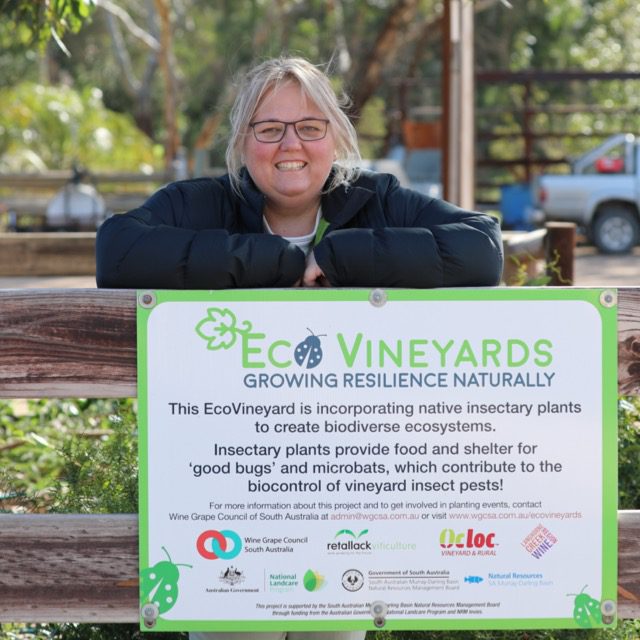1. Tell us about your experience in grape growing?
The Case Family have been growing grapes in Langhorne Creek since 1947 with some of the current vines in the Kimbolton vineyard dating back to 1966. Our parents, Len and Judy Case, oversaw all the current plantings on the property and are still actively involved in the day to day operations of the vineyard and Cellar Door.
Brad and I are siblings and grew up in the region and now jointly manage the vineyards, cellar door and our wine label, Kimbolton Wines.
Our passion is to be at the leading edge of Viticulture. We are aware of the impact farming has on the environment and we want to be able to hand the property on to the next generation with healthy soils and a healthy environment.
We have changed some of the varieties we grow to suit the changing climate. We still have the traditional Shiraz and Cabernet blocks, but we also have Montepulciano, Fiano and Carignan which are well suited to our hot summers. This is a good example for how we are trying to adapt to the changing environmental condition and educate our wine lovers about the new and exciting wine styles.
2. What prompted you to want to be involved in the EcoVineyards project?
Viticulture has evolved over the last 20 years. We are now far more aware of the impact pesticides are having on the environment and the eco-system of our vineyard. Our focus has also shifted to grow more premium grapes for our customers and our own label.
This shift in focus means we are constantly looking at ways to improve the overall management of the vineyard, including water use efficiency of the vineyard, chemical use and the environmental aspects of running a vineyard.
Langhorne Creek has always been very proactive with tree plantings and native revegetation and we have wood lots planted on the vineyard. However when these were planted we didn’t consider how the plantings would impact the insect and bird population, we just planted native vegetation.
We are hoping the EcoVineyards project will help guide us in the selection of plants for the vineyard and surrounding the cellar door, so the overall diversity of the property is improved.
3. What do you hope to achieve from your involvement in the EcoVineyards project?
We are excited about the change in direction the EcoVineyards project will have on the management of the vineyards and cellar door. Hopefully, we will have a greater understanding of the impact plant diversity can have on the overall health of the vineyard.
Our cellar door will play an important role in the project by giving us the opportunity to tell our EcoVineyards story direct to consumers. We want them to understand the importance of insects and diverse fauna has on viticulture and the resulting wine.
At the moment we do not use many insecticides in the vineyard and we’re hoping one of the major outcomes of being in this project will be that we can eliminate insecticides from our management strategy completely.
4. Have you tried to increase biodiversity on your property before undertaking this project? If so, how?
We have been instrumental in the the Angas Bremer Irrigators Revegetation Association program for the last decade. This program involved planting two hectares of trees for every 100 megalitres of Murray Darling Basin water licence.
The trees planted during this program have been maintained, and the understorey is managed to control weeds and vermin, but it has not been managed in a way that improves the insect biodiversity. We are re-visiting the existing areas and planting new sections to improve the insect corridors through and around the vineyard.
5. Why do you think it is so important for growers to try and build natural resilience on their property?
We are in the viticulture game for the long term. We want to be able to pass on a healthy vineyard to our children.
Agro-chemicals will remain as part of our management practice but we need to consider soil health and insecticide biodiversity to allow us to reduce the reliance on chemicals.
The weather patterns in Langhorne Creek are becoming more erratic and challenge the way we grow grapes in the region. We need grape varieties that are well adapted to variable weather conditions, but our vines also need to be resilient. Resilience is built from the soil up. If we can improve our soil and plant diversity, our whole vineyard ecosystem will be better in the future.
6. Looking to the future, what do you see as a new ‘normal’ for grape growers on their properties?
Farming has always been about adapting and modification, and viticulture is no different.
As the climate is changing to hotter drier summers we need to adapt with new varieties and modified management practices.
Twenty years ago, we never would have sprayed our vines with kelp now it is a regular practice. Similarly, we now apply mulch, kelps and humates to the soil to help improve the soil biota.
We have become accustomed to regularly spraying herbicides to keep a clean strip under the vines. This is practice is beginning to change as we investigate planting natives or small flowering annuals under the vines to help improve the soil structure in the vine strip.
Bio fungicides are also coming on to the market, allowing use to move away from broad spectrum fungicides.
We need to ensure we have a holistic outlook on managing the vineyard. We also need to incorporate the operational aspects of the cellar door in these management decisions to guide us through the next 20 years and beyond.

